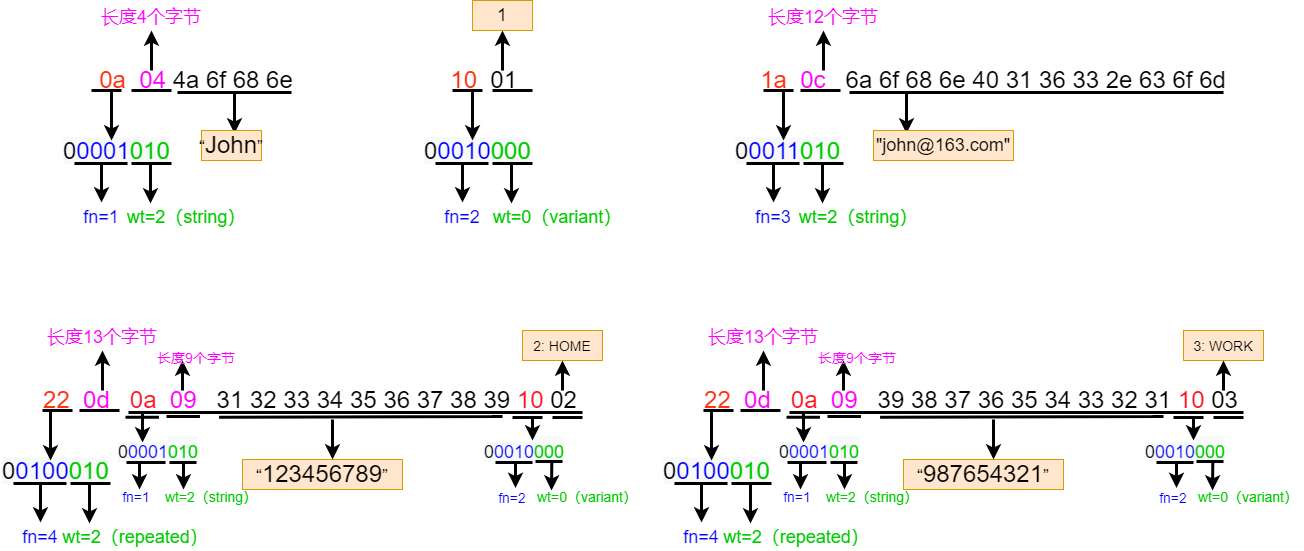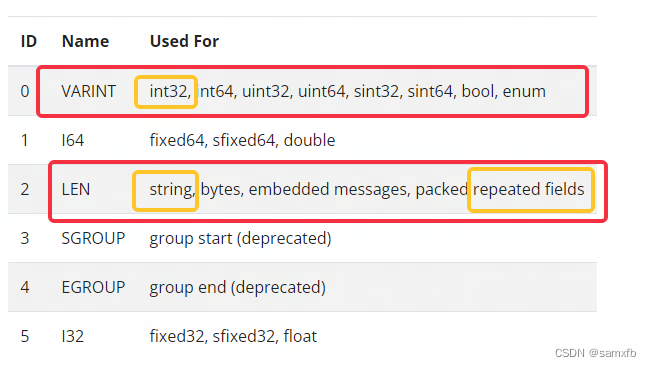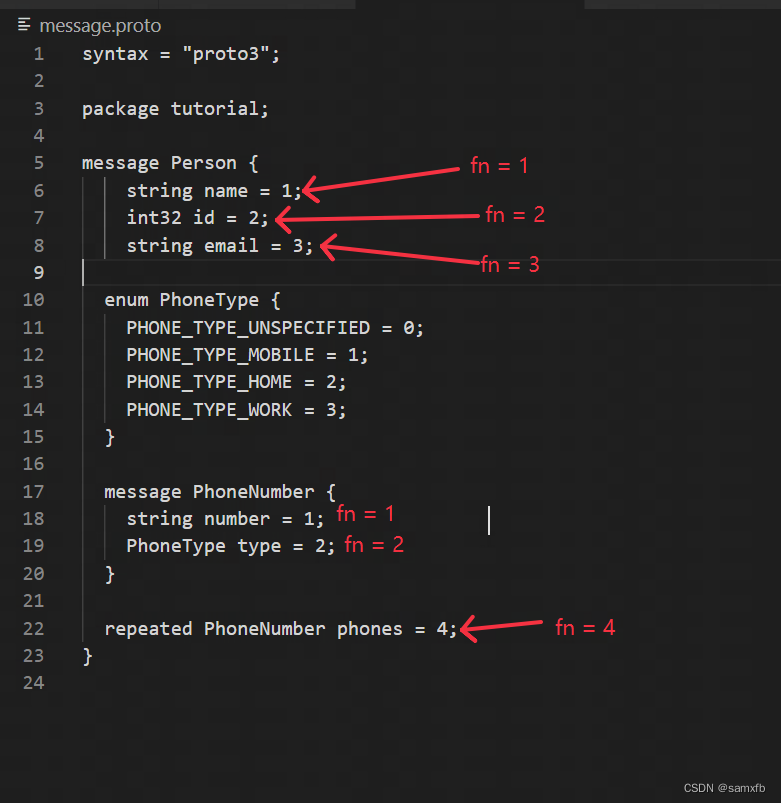- 1【AI绘画】AI绘画真的太强悍了!Stable Diffusion + ControlNet 骨架分析,输出的高清大图让我大吃一惊. 附安装使用教程_stable diffusion 骨架
- 2c语言如何理解指针的指针?
- 3K一最邻近算法在文本自动分类中的应用_k近邻算法在文本分类中的实践应用
- 4视频无水印爬虫采集工具|短视频批量下载软件|可导出视频分享链接_网页抖音视频视频提取
- 5vue中配置多个代理以及对应的axios设置多个路径_vue 本地代理使用两个基础路径
- 6Android Studio安装&Java开发环境配置详细教程_android studio java环境
- 7为什么?为什么程序员总是加班!
- 8径向基函数RBF三维网格变形_rbf变形
- 9c语言多字符和宽字符,2.1.5 多字节字符和宽字符
- 10查验发票真伪_python 查验发票
Protobuf 编码规则及c++使用详解_protobuf编码规则
赞
踩
Protobuf 编码规则及c++使用详解
Protobuf 介绍
Protocol Buffers (a.k.a., protobuf) are Google’s language-neutral, platform-neutral, extensible mechanism for serializing structured data
Protocol Buffers(简称为protobuf)是谷歌的语言无关、平台无关、可扩展的机制,用于序列化结构化数据。
protobuf的主要目的是在不同应用程序之间高效地传输和存储数据。与XML和JSON等文本格式相比,protobuf的编码格式更紧凑,解析速度更快,占用的存储空间更小。此外,protobuf还支持版本兼容性,使得在数据结构发生变化时能够向后兼容。
在音视频领域,信令和打点数据量非常大,采用JSON等文本方式,虽然可读性较大,但数据提交太大,不利于传输和节省带宽,因此二进制编码方式(protobuf)非常适合这个领域。
c++ 使用详解
1、定义.proto文件 (message.proto)
syntax = "proto3"; package tutorial; message Person { string name = 1; int32 id = 2; string email = 3; enum PhoneType { PHONE_TYPE_UNSPECIFIED = 0; PHONE_TYPE_MOBILE = 1; PHONE_TYPE_HOME = 2; PHONE_TYPE_WORK = 3; } message PhoneNumber { string number = 1; PhoneType type = 2; } repeated PhoneNumber phones = 4; }
- 1
- 2
- 3
- 4
- 5
- 6
- 7
- 8
- 9
- 10
- 11
- 12
- 13
- 14
- 15
- 16
- 17
- 18
- 19
- 20
- 21
- 22
- 23
包含了常用的整型,字符串,枚举,结构体,repeated(数组)类型
2、使用protoc编译器生成c++源码文件(message.pb.h, message.pb.cc)
protoc --cpp_out=. message.proto
libprotobuf和protoc编译器如何安装?
在ubuntu系统下:
# sudo apt update
# sudo apt install libprotobuf-dev protobuf-compiler
- 1
- 2
3、编写测试文件(main.cpp)
// g++ -std=c++11 main.cpp message.pb.cc -lprotobuf -o main #include "message.pb.h" #include <google/protobuf/util/json_util.h> #include <iostream> #include <fstream> #include <initializer_list> struct CppPerson { std::string name = "John"; int32_t id = 1; std::string email = "john@163.com"; enum CppPhoneType { UNSPECIFIED = 0, MOBILE = 1, HOME = 2, WORK = 3, }; struct CppPhoneNumber { std::string number; CppPhoneType type; }; std::vector<CppPhoneNumber> phones; }; int main() { // Create a CppPerson object CppPerson cpp_person; cpp_person.phones.push_back({"123456789", CppPerson::HOME}); cpp_person.phones.push_back({"987654321", CppPerson::WORK}); // 创建一个 Person 对象 tutorial::Person person; person.set_name(cpp_person.name); person.set_id(cpp_person.id); person.set_email(cpp_person.email); for (auto &s : cpp_person.phones) { auto phone = person.add_phones(); phone->set_number(s.number); phone->set_type(static_cast<tutorial::Person::PhoneType>(s.type)); } // 将 Person 对象序列化为字节流 std::string serialized; person.SerializeToString(&serialized); std::cout << "serialized size: " << serialized.size() << std::endl; // message <--> json std::string json; google::protobuf::util::JsonOptions json_options; // json_options.add_whitespace = true; google::protobuf::util::MessageToJsonString(person, &json, json_options); std::cout << "JSON: " << json << std::endl; std::cout << "JSON size: " << json.size() << std::endl; tutorial::Person person_from_json; google::protobuf::util::JsonStringToMessage(json, &person_from_json); std::string person_from_json_serialized; person_from_json.SerializeToString(&person_from_json_serialized); std::cout << "Person from JSON serialized size: " << person_from_json_serialized.size() << std::endl; // 将字节流写入文件 std::fstream output("person.bin", std::ios::out | std::ios::binary); output.write(serialized.c_str(), serialized.size()); output.close(); // 从文件中读取字节流 std::fstream input("person.bin", std::ios::in | std::ios::binary); std::string serialized_input((std::istreambuf_iterator<char>(input)), std::istreambuf_iterator<char>()); // 将字节流反序列化为 Person 对象 tutorial::Person person2; person2.ParseFromString(serialized_input); // 输出 Person 对象的信息 std::cout << "Person:" << std::endl; std::cout << " name: " << person2.name() << std::endl; std::cout << " id: " << person2.id() << std::endl; std::cout << " email: " << person2.email() << std::endl; for (int i = 0; i < person2.phones_size(); i++) { auto &phone_number = person2.phones(i); std::cout << " phone number: " << phone_number.number() << std::endl; std::cout << " phone type: " << phone_number.type() << std::endl; } return 0; }
- 1
- 2
- 3
- 4
- 5
- 6
- 7
- 8
- 9
- 10
- 11
- 12
- 13
- 14
- 15
- 16
- 17
- 18
- 19
- 20
- 21
- 22
- 23
- 24
- 25
- 26
- 27
- 28
- 29
- 30
- 31
- 32
- 33
- 34
- 35
- 36
- 37
- 38
- 39
- 40
- 41
- 42
- 43
- 44
- 45
- 46
- 47
- 48
- 49
- 50
- 51
- 52
- 53
- 54
- 55
- 56
- 57
- 58
- 59
- 60
- 61
- 62
- 63
- 64
- 65
- 66
- 67
- 68
- 69
- 70
- 71
- 72
- 73
- 74
- 75
- 76
- 77
- 78
- 79
- 80
- 81
- 82
- 83
- 84
- 85
- 86
- 87
- 88
- 89
4、编译运行
# g++ -std=c++11 main.cpp message.pb.cc -lprotobuf -o main # ./main serialized size: 52 JSON: {"name":"John","id":1,"email":"john@163.com","phones":[{"number":"123456789","type":"PHONE_TYPE_HOME"},{"number":"987654321","type":"PHONE_TYPE_WORK"}]} JSON size: 152 Person from JSON serialized size: 52 Person: name: John id: 1 email: john@163.com phone number: 123456789 phone type: 2 phone number: 987654321 phone type: 3
- 1
- 2
- 3
- 4
- 5
- 6
- 7
- 8
- 9
- 10
- 11
- 12
- 13
- 14
- 15
- 16
- 17
查看编码好的二进制(person.bin)

5、编码后二进制流分析

编码规则
第一个字节包含了字段编号(Filed Number)和wired type, 组合起来代表message里一个字段的Key信息
bit 7
0-代表该字节自解释完整
1-代表后续还有字节,需要整合后续字节提取信息 (当字段数超过15个是采用这种方式,即由多个字节编码key)
<这个bit就是varint的关键功能位,variant中每个字节的最高位bit称之为most significant bit(MSB),如果该bit为0意味着这个字节为表示当前整数的最后一个字节,如果为1则表示后面还有至少1个字节,可见,varint的终止位置其实是自解释的。>
bit 6-bit 3
存储字段编号,field number (fn)
bit 2-bit 0
存储wired type (wt)
常用的类型主要有VARINT和LEN
- wire type=0、1、5,编码为key+数据,只有一个数据,可能占数个字节,数据在编码时自带终止标记;
- wire type=2,编码为key+length+数据,length指示了数据长度,可能有多个数据,顺序排序


总结:二进制流存储方式为key data key data key data…
比如上述例子:

6、番外:protobuf和JSON互转
如上述示例,转换为的json为:
JSON: {"name":"John","id":1,"email":"john@163.com","phones":[{"number":"123456789","type":"PHONE_TYPE_HOME"},{"number":"987654321","type":"PHONE_TYPE_WORK"}]}
JSON size: 152
- 1
- 2
可见JSON紧压缩方式大小为152Byte,而PB压缩大小为52Byte,非常省空间。
Protobuf,它只需要简单地将一个二进制序列,按照指定的格式读取到C++对应的结构类型中就可以了。消息的decoding过程也可以通过几个位移操作组成的表达式计算即可完成。而对于字符串、自定义对象类型的数据,Protobuf在存储的时候,也存储了该数据的字节长度,读取起来也非常快。



